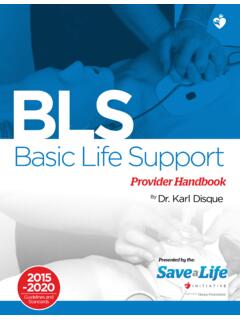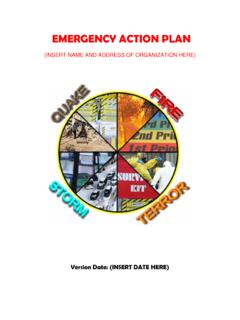Transcription of THE ESSENTIAL GUIDE TO FIRST AID - St. Andrew's First Aid
1 THE ESSENTIAL GUIDE TOWHAT TO DO TO KEEP YOUR FAMILY SAFEFIRSTAID4 HOW TO PERFORM CPR Technique can keep someone alive until emergency services arrive on the scene6 STROKE Use the FAST (Face-Arm-Speech-Time) GUIDE to check if a stroke has occured8 STRAINS & SPRAINS Treat using the RICE procedure - Rest, Ice, Comfortable support and Elevation of injury10 HOW TO RECOGNISE A HEART ATTACK Quickly ease strain on casualty s heart then get them to nearest hospital 12 RECOVERY POSITION Safely treat an unresponsive adult14 DEALING WITH CHOKING Removing obstruction is top priority16 NOSEBLEEDS Keep airway open and control bleeding17 BURNS Simple tips to relieve pain and swelling and ensure risk of infection is minimised 18 FAINTING It is vital to keep blood flowing to brain19 ASTHMA An easy GUIDE to help ease the casualty s breathing until
2 Medical help arrives20 SHOCK Helping to improve blood supply to the casualty s vital organs is imperative22 STINGS Pinching the sting with fingers or tweezers can spread the venomWhether it s knowing what to do if someone is choking or how to help if they ve suffered a cardiac arrest FIRST aid saves Daily Record has teamed up with St Andrew s FIRST Aid to produce an ESSENTIAL GUIDE for the home on how to help someone in Dorman, operations and policy director of St Andrew s FIRST Aid Training & Supplies Ltd, said: We firmly believe that everybody should know FIRST aid.
3 It s a life skill that everybody should have. Anybody can injure themselves or become ill and everybody should be able to assist. The younger we can teach people, the better, because it is such an important skill to have. We believe that nobody should die because they needed FIRST aid. Skills range from providing some TLC and just reassuring someone right through to performing CPR which is a life-saving skill. The average response time for an ambulance is eight minutes and it can take up to four minutes for someone to choke to death. Helping someone choking is such a simple procedure and FIRST aid is not a difficult subject to learn.
4 We believe doing something is better than doing nothing. St Andrew s FIRST Aid Training and Supplies Ltd train about 15,000 people a year throughout Scotland in skills to not only save lives but also comfort people in ve teamed up with the Daily Record to produce this GUIDE for the home to help people with some of the basic FIRST aid skills that could help save explained: We ve tried to present this in a simple, logical manner with images to assist people in learning aspects of FIRST aid. Other ways to learn are attending a course or going on to our website as you can learn online as well.
5 We would certainly encourage people to keep this supplement handy and refer to it as much as possible. The Daily Record along with St Andrew s FIRST Aid are saving lives. THE ESSENTIAL GUIDE TO FIRST AIDCONTENTSHOW TO PERFORM CPRTHE ESSENTIAL GUIDE TO FIRST AIDTHE ESSENTIAL GUIDE TO FIRST AID45 Check the casualty s response gently shake his shoulders and ask him/her if he/she can hear there is no response from him/her open the casualty s airway and check for breathing tilt his head back and lift his/her chin to open his airway. Put your face down near the casualty s face and look, listen and feel for normal breathing.
6 If the casualty is not breathing normally or not at all shout for help, ask someone to call 999/112 for an ambulance and to fetch an AED ( automated external defibrillator ) if possible. If you are on your own, call the ambulance CPR by giving 30 chest compressions by clasping your hands together and placing them in the centre of the casualty s chest and compressing it between 5-6cm at a rate of 100-120 compressions per you have delivered 30 compressions, give the casualty two rescue breaths. Open his/her airway by tilting his head back and putting two fingers of one of your hands on the tip of his chin and with two fingers of your other hand pinch his nostrils closed.
7 Take a breath and put your lips over the casualty s mouth and breathe into it. A rescue breath should last about a second and you should see the casualty s chest rise if it has been effective. Give a second t worry if you haven t had any training in CPR or you are unwilling to give rescue breaths. Delivering only chest compressions is preferable to doing nothing. Keep alternating between 30 chest compressions and two rescue breaths until the casualty shows signs of becoming responsive or you become too exhausted to AID STEPSS imple technique can save a life134562 Follow step-by-step GUIDE to learn what to do when a casualty is unresponsiveHOW TO USE AN automated external DEFIBRILLATOR1.
8 Switch on AED and take pads out of sealed pack. Remove clothing and wipe away sweat if Remove backing paper and place pad on casualty s chest in the postion Place the second pad just below their armpit. The AED will start anaylsing the heart Follow the voice and/or visual prompts given by the TO RECOGNISE A STROKETHE ESSENTIAL GUIDE TO FIRST AIDTHE ESSENTIAL GUIDE TO FIRST AID67 While looking at the casualty s face, ask him/her to smile. Only one side of his/her mouth may rise and the other side may droop if he/she has had a stroke.
9 Ask the casualty to try to raise both his/her arms at the same time. He/she may only be able to lift one arm if he/she has had a stroke. Check to see if the casualty can speak clearly to you and understand what you are saying to him/her. Call 999/112 immediately and advise the ambulance dispatcher that you have used the FAST test and suspect the casualty has had a AID STEPS If the casualty is responsive, help him to lie down with his head and shoulders raised and advise him that help is on the way. Keep monitoring the casualty s breathing, pulse and level of response while waiting for the FAST test identifies the three most common symptoms of look at the casualty s face and ask him/her to smile.
10 Has his/her face fallen on one side?arms ask him/her to raise both of his/her arms and keep them there. Is he/she unable to raise one arm?speeCh ask him/her to tell you their name, or say hello . Is their speech slurred?time if you spot any of these signs, call 999 999/112 For emergenCy help if the casualty becomes unresponsive, open the airway and check breathing. REMEMBERREMEMBER TO ACT FASTMake sure the casualty is comfortable before calling for helpCheck for facial weakness, arm weakness, speech problems, numbness, sudden loss of vision, confusion, sudden, severe headache and :A stroke occurs when the blood supply to the brain is disrupted either by a blood clot or a ruptured blood vessel.








